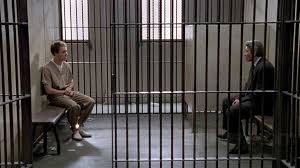House ridden for what felt like years, cabin fever began to set in. As the monotonous Michigan winter meandered by, my friends and I searched the abyss that is Xfinity on Demand for a movie. Starting the search for Agent Cody Banks, we quickly altered our focus towards films starring Frankie Muniz, and due to the unfortunate fact that Big Fat Liar had been on replay for the previous two days, we decided to watch the Gregory Hoblit film, Primal Fear, starring Richard Gere, and Edward Norton. I quickly became infatuated with the film, particularly the character development of Gere’s Martin Vail, and Norton’s, Aaron Stampler. After re-watching Hoblit’s Primal Fear several times, I began to draw connections between the juxtaposition of Richard Gere’s and Edward Norton’s characters respectively, and Robert McCuer’s notion of compulsory able-bodiness, resulting in an unexpected, Grisham meets Hitchcockian, thrilling ending.
The film, Primal Fear, follows the trial of an awkward, mumbling, simple, and apparently sickly, Aaron Stampler, who was accused in the murder of Archbishop Rushman. Richard Gere, as Martin Vail, a world-renown defense attorney, with what we learn to be questionable motives surrounding his own fame, takes on Stampler’s case pro-bono, attempting to prevent his ex-girlfriend and prosecutor, Janet Venable from winning the “slam-dunk” case with the death penalty. The film has it all from murder, to questionable Archbishop-altar boy relationships, to Law and Order on steroids, meets Maury Show relationship issues, culminating with insanity charges and a plot twist that makes you question everything in the movie. The thrilling ending can be best understood by studying Hoblit’s character development through the lens that is Queer Studies in general, and the notion of “compulsory able-bodiness,” specifically.
Robert McCuer believes that compulsory heterosexuality, the impression that people should be heterosexual or something is wrong with them (they are “queer”), is a result of the same system that produces compulsory able-bodiness. Along the same lines as compulsory heterosexuality, compulsory able-bodiness, assumes that “normalcy,” revolves around an able-bodied person; disability being abnormal, and in literary texts, dissociative. Martin F. Norden explains this relationship between disabled and able-bodied characters in literature, and the audiences consequent association with such characters under the umbrella that is “The Cinema of Isolation.” Norden believes that the juxtaposition of ableness with disability “enhances the disabled characters’ isolation and “otherness” by reducing them to objectifications of pity, fear, scorn, etc.- in short, object of spectacle.” It is this manipulation of what Norden refers to as “the CInema of Isolation,” that allows for Primal Fear’s spectacular ending, as the entirety of the film is spent “objectifying” Stampler as a spectacle in comparison to Vail’s superiority.
This juxtaposition of Stampler and Vail is illustrated from the onset of the movie as Vail is immediately characterized as an extremely successful defense attorney, with an unequivocal grace while speaking. This is obviously contrasted by Stampler’s constant stutter, and the simplicity of his conversations. This objectification of Stampler as a disabled, helpless character compared to Vail’s utter brilliance is on display various times as Vail tells Stampler that, “I am your attorney. Which means that I am your mother, your father, your best friend, and your priest,” and continues as we learn of Stampler’s “black outs,” and apparent schizophrenic personality traits. Further, as McCuer explains, since we as an audience associate with the able-bodied, character our allegiance moves towards Vail, resulting in sympathy towards the mentally ill Aaron Stampler. Vail declares, “I chose to believe in the basic goodness of people. Some basically good people do some very bad things,” and we as an audience agree, sympathizing with the disabled Stampler. Vail goes on to state, “We have two victims, and no suspects,” and again we agree, blinded by the nature of the “cinema of isolation.” with Stampler being the victim of such isolation.
It is this isolation of the disabled Stampler that allows for such a thrilling ending to take place. After Stampler is pushed to his limit in court, his murderous, schizophrenic alter-personality, attacks back at the prosecution. His isolation is at its peak. Vail believes that he has proved Aaron Stampler’s mental illness and thus his “innocence” The prosecution is completely terrified, and the court is seemingly convinced of the Stampler’s insanity. This manipulation of compulsory able-bodiness continues until Stampler reveals, under the protection of attorney-client privilege that he is not schizophrenic, his mental illness being central to his plan of avoiding the conviction. It was all an act. He fooled everyone.
Examining Hoblit’s Primal Fear from a queer studies perspective not only provides insight towards the audience’s overall association with characters in the film, but also illustrates the greater societal structures influencing our perception of events. Ultimately the film closes with a shot of Martin Vail standing alone outside the courtroom, the isolation of the film now on his shoulders, as he and the audience are forced, to ask the question: What just happened?

